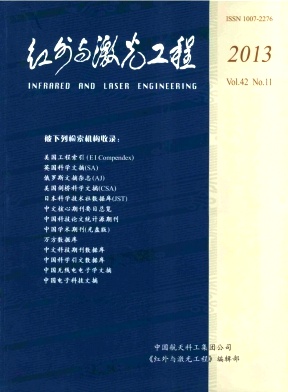Xue Song, Han Guangliang. Fast capture of appointed infrared targets based on estimation of rotation angle[J]. Infrared and Laser Engineering, 2013, 42(11): 2907-2912.
| Citation:
|
Xue Song, Han Guangliang. Fast capture of appointed infrared targets based on estimation of rotation angle[J]. Infrared and Laser Engineering, 2013, 42(11): 2907-2912.
|
Fast capture of appointed infrared targets based on estimation of rotation angle
- 1.
Changchun Institute of Optics,Fine Mechanics and Physics,Chinese Academy of Sciences,Changchun 130033,China;
- 2.
University of Chinese Academy of Sciences,Beijing 100049,China
- Received Date: 2013-03-11
- Rev Recd Date:
2013-04-07
- Publish Date:
2013-11-25
-
Abstract
For the problem of recognizing infrared targets, a method based on estimation of rotation angle was proposed. The method first segmented the image by local adaptive threshold and mark connected areas. Integral image was used to accelerate the computation of the local threshold. The connected areas were resized to the same size. The pixel values of the resized images were used as features. Then the rotation angle of the target was estimated by a neural network. Some areas were filtered during the estimation. At last, the area was recognized by another neural network. For some applications, the number of sample was not sufficient and a little difference existed between the samples and targets. For this problem, a method based on random growth and erosion was proposed to generate samples. Experiments show the method is effective and has a high recognizing rate even when the shape of samples is not exact.
-
References
|
[1]
|
Fan Jinxiang, Zhang Yuan, Wang Sheyang. Analysis of application status of ATR technologies in infrared imaging guided missiles[J]. Infrared and Laser Engineering, 2007, 36(6): 778-781. (in Chinese)范晋祥, 张渊, 王社阳. 红外成像制导导弹自动目标识别应用现状的分析[J]. 红外与激光工程, 2007, 36(6): 778-781. |
|
[2]
|
|
|
[3]
|
|
|
[4]
|
Fu Yan, Wang Mei, Zhang Chunqin. SAR image target recognition based on Hu invariant Moments and SVM[C]//Fifth International Conference on Information Assurance and Security, 2009: 585-588, |
|
[5]
|
|
|
[6]
|
Singh C, Walia E, Mittal N. Rotation invariant complex Zernike moments features and their applications to human face and character recognition[C]//The Institution of Engineering and Technology, 2011: 255-266. |
|
[7]
|
Wan Lei, Zeng Wenjing, Zhang Tiedong, et al. Real-time detection of marine infrared objects based on the fusion of gradient information[J]. Infrared and Laser Engineering, 2013, 42(1): 41-45. (in Chinese)万磊, 曾文静, 张铁栋, 等. 基于梯度信息融合的海面红外目标实时检测[J]. 红外与激光工程, 2013, 42(1): 41-45. |
|
[8]
|
|
|
[9]
|
|
|
[10]
|
Li Junmei, Hu Yihua, Tao Xiaohong. Recognition method based on principal component analysis and back-propagation neural network[J]. Infrared and Laser Engineering, 2005, 34(6): 719-723. (in Chinese)李军梅, 胡以华, 陶小红. 基于主成分分析与BP神经网络的识别方法研究[J]. 红外与激光工程, 2005, 34(6): 719-723. |
|
[11]
|
Minoru Fukumi, Sigeru Omatu. Rotation-invariant neural pattern recognition system estimating a rotation angle[C]//IEEE Transactions on Neural Networks, 1997: 568-581. |
|
[12]
|
|
|
[13]
|
Shen Han. Segmentation for uneven lighting document image[D]. Shanghai: East China Normal University, 2006. (in Chinese)沈晗. 非均匀光照文本图像的分割[D]. 上海: 华东师范大学, 2006. |
|
[14]
|
|
|
[15]
|
Gao Jing, Sun Jiyin, Liu Jing, et al. FLIR target recognition based on local fuzzy threshold[J]. Optics and Precision Engineering, 2011, 19(12): 3056-3063. (in Chinese)高晶, 孙继银, 刘婧, 等. 基于区域模糊阈值的前视红外目标识别[J]. 光学 精密工程, 2011, 19(12): 3056-3063. |
|
[16]
|
|
|
[17]
|
Jin Yongliang, Wang Yanjie, Liu Yanying. Pre-detection method for small infrared target[J]. Optics and Precision Engineering, 2012, 20(1): 171-178.靳永亮, 王延杰, 刘艳滢, 等. 红外弱小目标的分割预检测[J]. 光学 精密工程, 2012, 20(1): 171-178. |
-
-
Proportional views

-









 DownLoad:
DownLoad: